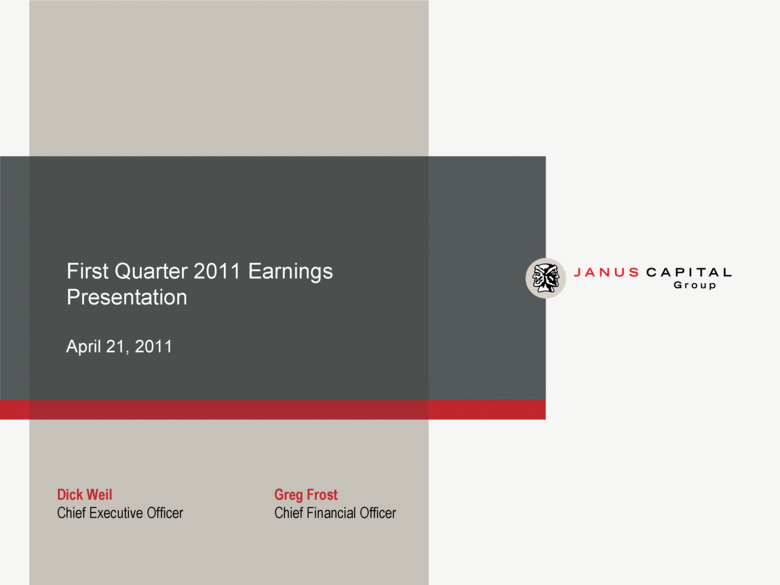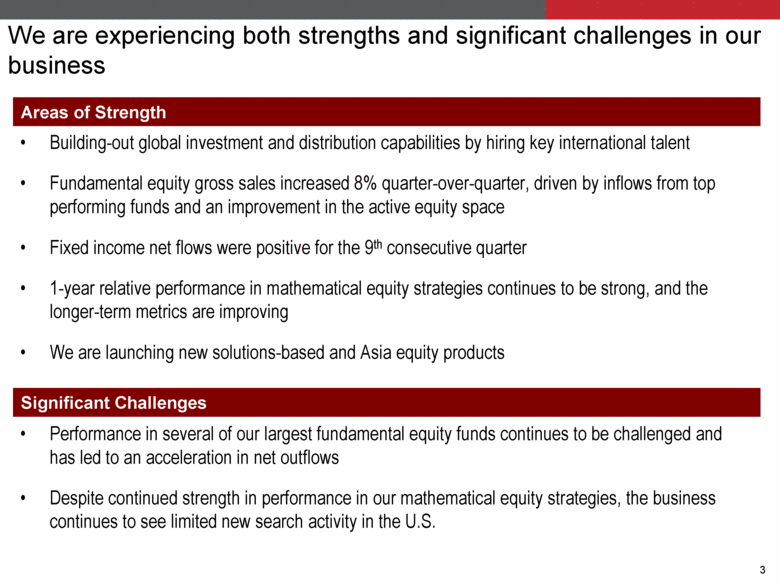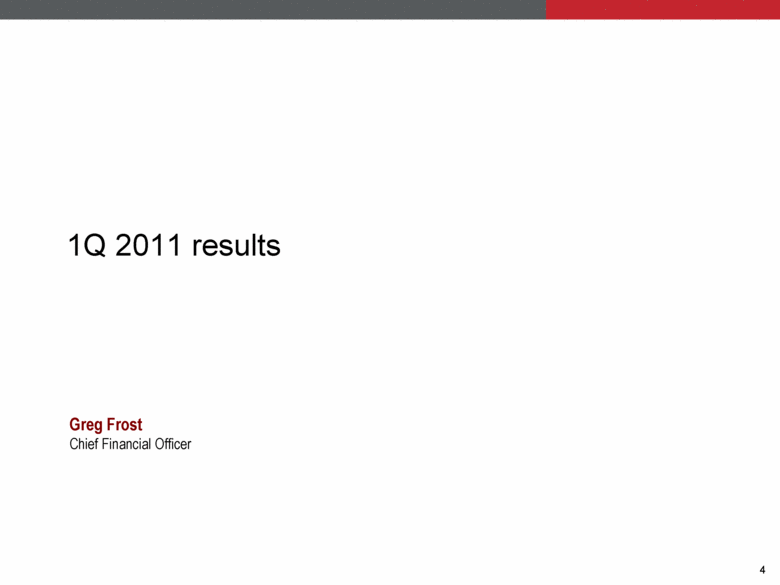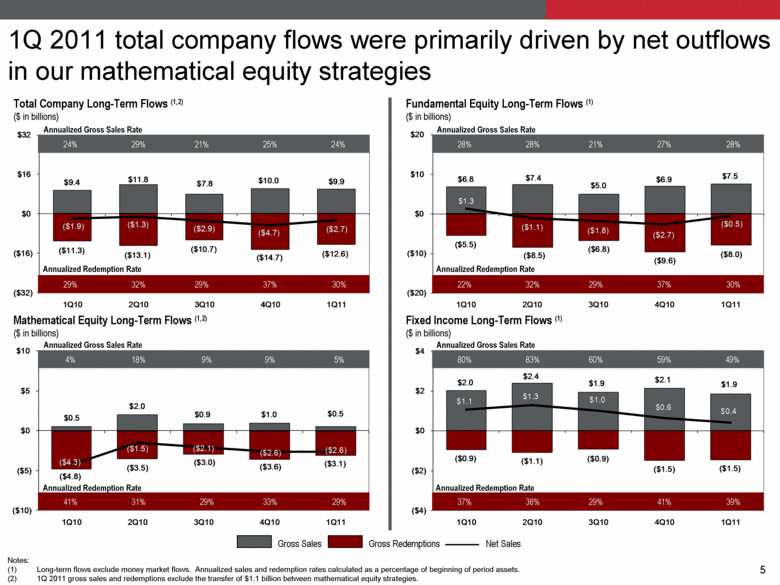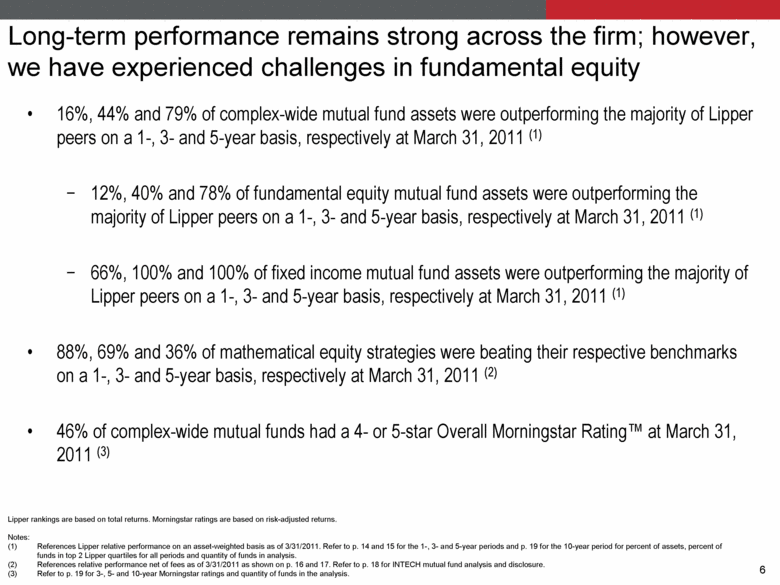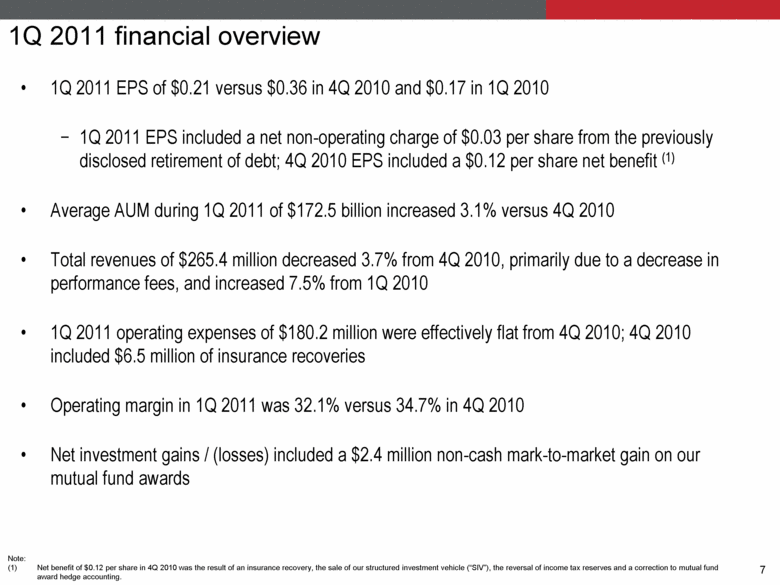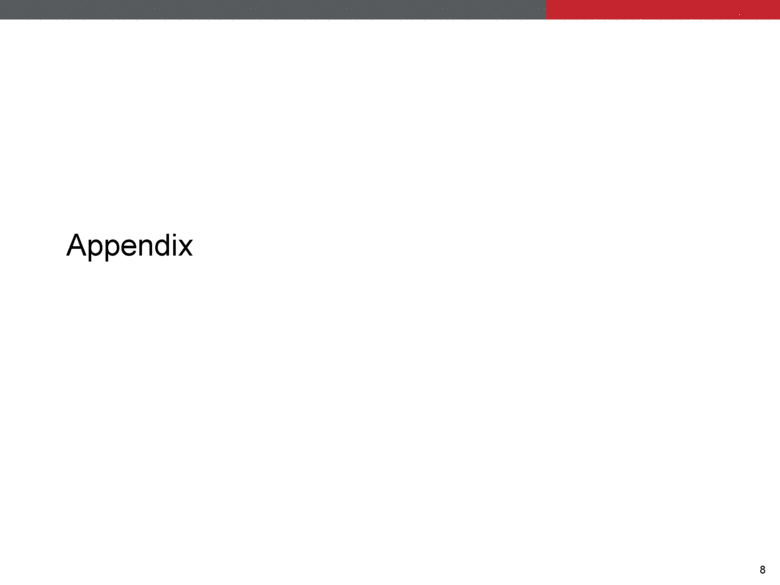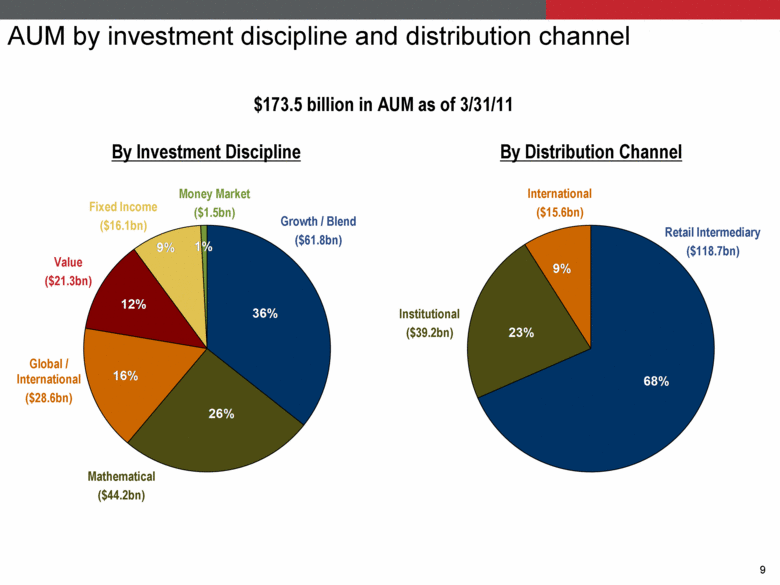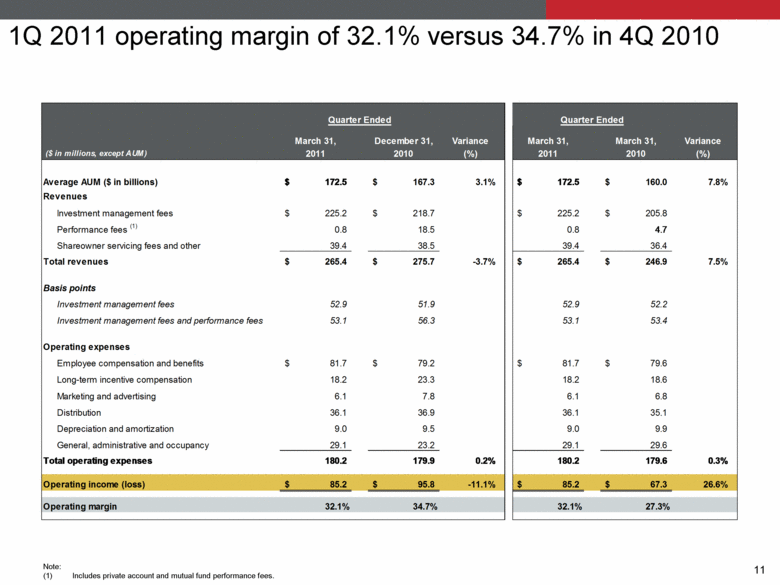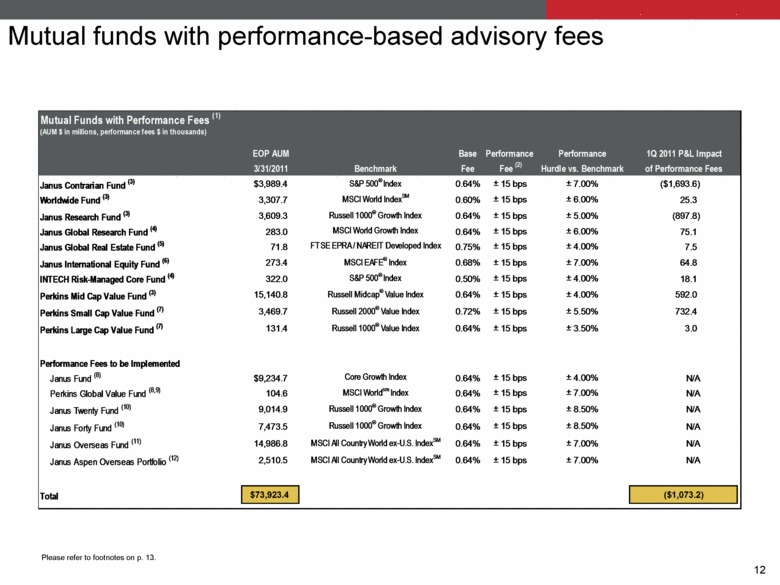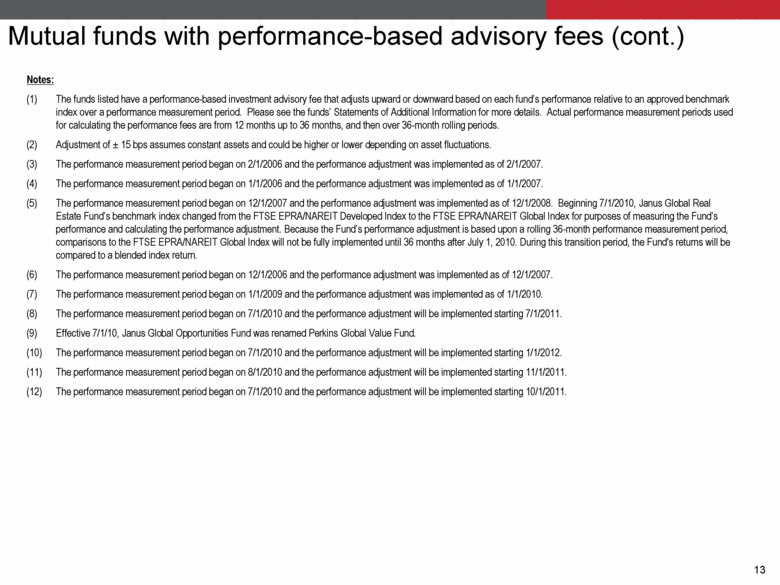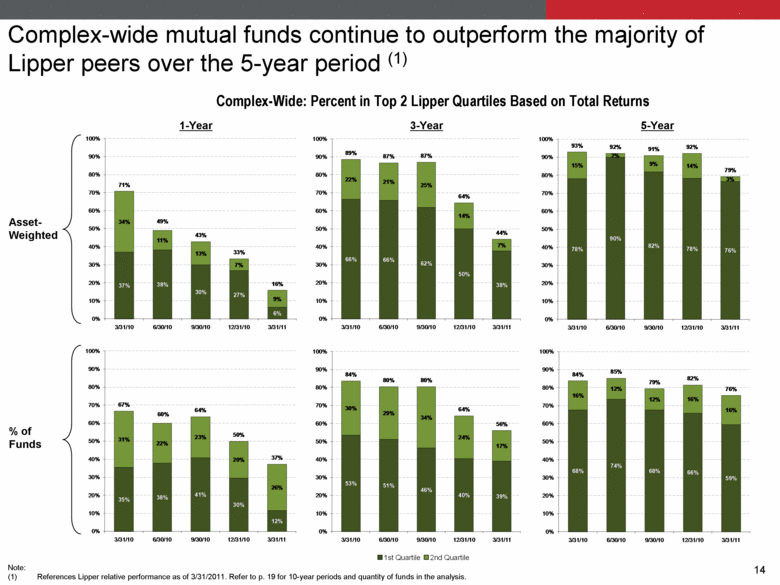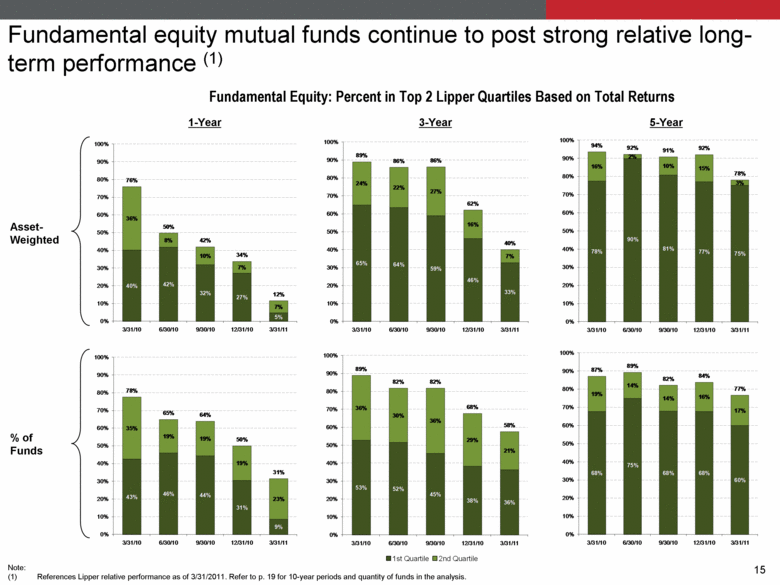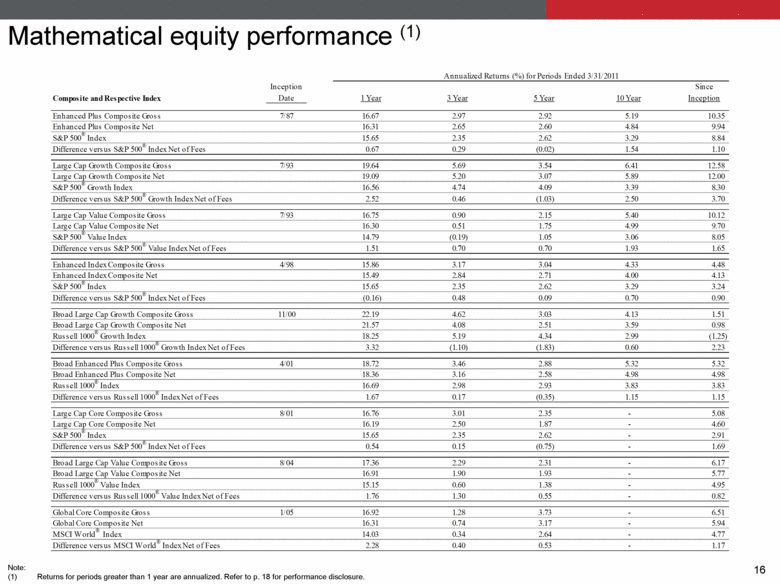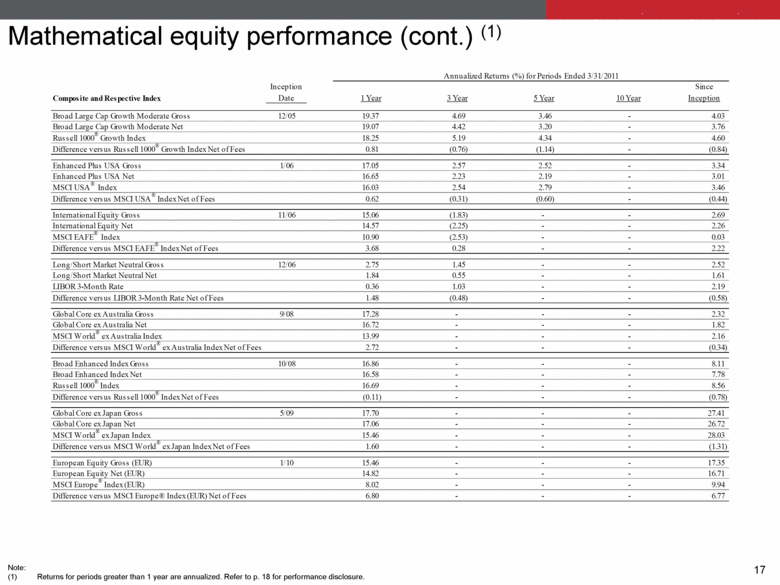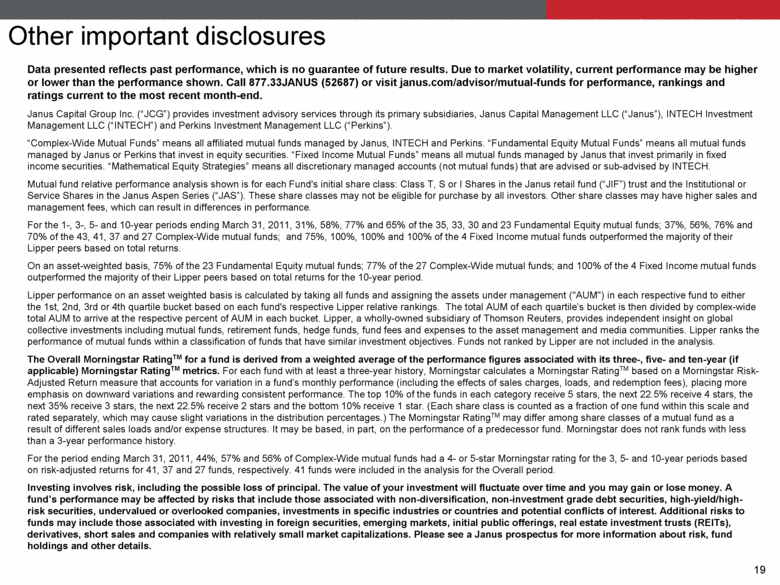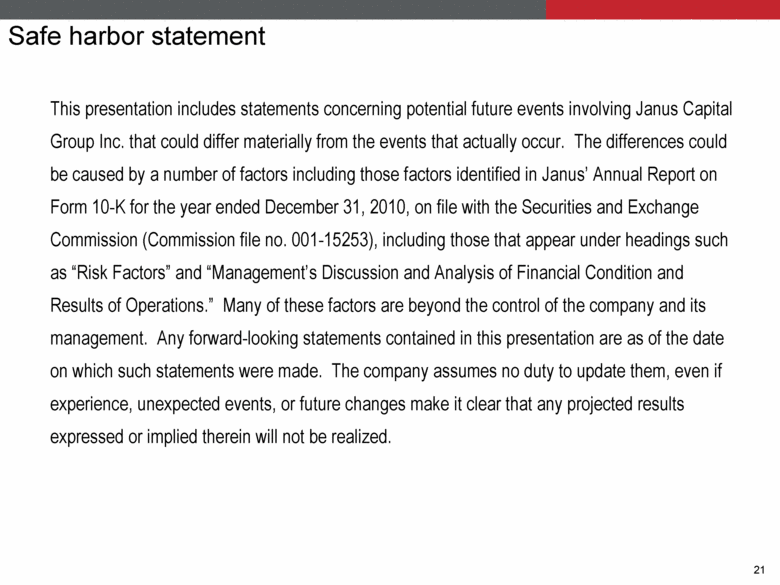Attached files
| file | filename |
|---|---|
| 8-K - 8-K - JANUS CAPITAL GROUP INC | a11-8834_38k.htm |
| EX-99.1 - EX-99.1 - JANUS CAPITAL GROUP INC | a11-8834_3ex99d1.htm |
Exhibit 99.2
|
|
First Quarter 2011 Earnings Presentation April 21, 2011 Dick Weil Chief Executive Officer Greg Frost Chief Financial Officer |
|
|
EPS – 1Q 2011 EPS of $0.21 compared to $0.36 in 4Q 2010 and $0.17 in 1Q 2010 Margin – Operating margin in 1Q 2011 remained above 30% at 32.1% versus 34.7% in 4Q 2010 and 27.3% in 1Q 2010 AUM – Assets Under Management at March 31, 2011 of $173.5 billion increased 2.4% versus December 31, 2010 Long-Term Net Flows – Janus’ total company long-term net flows were $(2.7) billion in 1Q 2011 compared to $(4.7) billion in 4Q 2010 Balance Sheet – On April 20, 2011 the Board of Directors declared a regular, quarterly cash dividend of $0.05 per share, payable May 13, 2011 to shareholders of record as of May 2, 2011 Janus Capital Group 1Q 2011 executive summary |
|
|
Building-out global investment and distribution capabilities by hiring key international talent Fundamental equity gross sales increased 8% quarter-over-quarter, driven by inflows from top performing funds and an improvement in the active equity space Fixed income net flows were positive for the 9th consecutive quarter 1-year relative performance in mathematical equity strategies continues to be strong, and the longer-term metrics are improving We are launching new solutions-based and Asia equity products Performance in several of our largest fundamental equity funds continues to be challenged and has led to an acceleration in net outflows Despite continued strength in performance in our mathematical equity strategies, the business continues to see limited new search activity in the U.S. We are experiencing both strengths and significant challenges in our business Areas of Strength Significant Challenges |
|
|
1Q 2011 results Greg Frost Chief Financial Officer |
|
|
Notes: Long-term flows exclude money market flows. Annualized sales and redemption rates calculated as a percentage of beginning of period assets. 1Q 2011 gross sales and redemptions exclude the transfer of $1.1 billion between mathematical equity strategies. 1Q 2011 total company flows were primarily driven by net outflows in our mathematical equity strategies 24% 29% 21% 25% 24% Total Company Long-Term Flows (1,2) ($ in billions) Mathematical Equity Long-Term Flows (1,2) ($ in billions) Fundamental Equity Long-Term Flows (1) ($ in billions) Gross Redemptions Gross Sales Net Sales 29% 32% 29% 37% 30% Annualized Redemption Rate Annualized Gross Sales Rate Fixed Income Long-Term Flows (1) ($ in billions) 28% 28% 21% 27% 28% 22% 32% 29% 37% 30% Annualized Redemption Rate Annualized Gross Sales Rate 4% 18% 9% 9% 5% 41% 31% 29% 33% 29% Annualized Redemption Rate Annualized Gross Sales Rate 80% 83% 60% 59% 49% 37% 38% 29% 41% 39% Annualized Redemption Rate Annualized Gross Sales Rate $0.5 $2.0 $0.9 $1.0 $0.5 ($4.8) ($3.5) ($3.0) ($3.6) ($3.1) ($4.3) ($1.5) ($2.1) ($2.6) ($2.6) ($10) ($5) $0 $5 $10 1Q10 2Q10 3Q10 4Q10 1Q11 $9.4 $11.8 $7.8 $10.0 $9.9 ($11.3) ($13.1) ($10.7) ($14.7) ($12.6) ($1.9) ($1.3) ($2.9) ($4.7) ($2.7) ($32) ($16) $0 $16 $32 1Q10 2Q10 3Q10 4Q10 1Q11 $6.8 $7.4 $5.0 $6.9 $7.5 ($5.5) ($8.5) ($6.8) ($9.6) ($8.0) $1.3 ($1.1) ($1.8) ($2.7) ($0.5) ($20) ($10) $0 $10 $20 1Q10 2Q10 3Q10 4Q10 1Q11 (1) (2) |
|
|
16%, 44% and 79% of complex-wide mutual fund assets were outperforming the majority of Lipper peers on a 1-, 3- and 5-year basis, respectively at March 31, 2011 (1) 12%, 40% and 78% of fundamental equity mutual fund assets were outperforming the majority of Lipper peers on a 1-, 3- and 5-year basis, respectively at March 31, 2011 (1) 66%, 100% and 100% of fixed income mutual fund assets were outperforming the majority of Lipper peers on a 1-, 3- and 5-year basis, respectively at March 31, 2011 (1) 88%, 69% and 36% of mathematical equity strategies were beating their respective benchmarks on a 1-, 3- and 5-year basis, respectively at March 31, 2011 (2) 46% of complex-wide mutual funds had a 4- or 5-star Overall Morningstar Rating™ at March 31, 2011 (3) Long-term performance remains strong across the firm; however, we have experienced challenges in fundamental equity Lipper rankings are based on total returns. Morningstar ratings are based on risk-adjusted returns. Notes: References Lipper relative performance on an asset-weighted basis as of 3/31/2011. Refer to p. 14 and 15 for the 1-, 3- and 5-year periods and p. 19 for the 10-year period for percent of assets, percent of funds in top 2 Lipper quartiles for all periods and quantity of funds in analysis. References relative performance net of fees as of 3/31/2011 as shown on p. 16 and 17. Refer to p. 18 for INTECH mutual fund analysis and disclosure. Refer to p. 19 for 3-, 5- and 10-year Morningstar ratings and quantity of funds in the analysis. (1) (2) (3) |
|
|
1Q 2011 EPS of $0.21 versus $0.36 in 4Q 2010 and $0.17 in 1Q 2010 1Q 2011 EPS included a net non-operating charge of $0.03 per share from the previously disclosed retirement of debt; 4Q 2010 EPS included a $0.12 per share net benefit (1) Average AUM during 1Q 2011 of $172.5 billion increased 3.1% versus 4Q 2010 Total revenues of $265.4 million decreased 3.7% from 4Q 2010, primarily due to a decrease in performance fees, and increased 7.5% from 1Q 2010 1Q 2011 operating expenses of $180.2 million were effectively flat from 4Q 2010; 4Q 2010 included $6.5 million of insurance recoveries Operating margin in 1Q 2011 was 32.1% versus 34.7% in 4Q 2010 Net investment gains / (losses) included a $2.4 million non-cash mark-to-market gain on our mutual fund awards 1Q 2011 financial overview Note: (1) Net benefit of $0.12 per share in 4Q 2010 was the result of an insurance recovery, the sale of our structured investment vehicle (“SIV”), the reversal of income tax reserves and a correction to mutual fund award hedge accounting. |
|
|
Appendix |
|
|
Value ($21.3bn) Retail Intermediary ($118.7bn) $173.5 billion in AUM as of 3/31/11 By Investment Discipline By Distribution Channel Growth / Blend ($61.8bn) Money Market ($1.5bn) Global / International ($28.6bn) Fixed Income ($16.1bn) Mathematical ($44.2bn) Institutional ($39.2bn) International ($15.6bn) AUM by investment discipline and distribution channel 36% 26% 16% 12% 9% 1% 23% 9% 68% |
|
|
Consolidated Entity 1Q 2011 EPS of $0.21 compared to $0.36 in 4Q 2010 March 31, December 31, Variance March 31, March 31, Variance ($ in millions, except AUM and per share) 2011 2010 (%) 2011 2010 (%) Average AUM ($ in billions) 172.5 $ 167.3 $ 3.1% 172.5 $ 160.0 $ 7.8% Revenues 265.4 $ 275.7 $ -3.7% 265.4 $ 246.9 $ 7.5% Operating expenses 180.2 179.9 0.2% 180.2 179.6 0.3% Operating income (loss) 85.2 $ 95.8 $ -11.1% 85.2 $ 67.3 $ 26.6% Operating margin 32.1% 34.7% 32.1% 27.3% Interest expense (13.2) $ (15.9) $ 17.0% (13.2) $ (15.6) $ 15.4% Investment gains (losses), net 1.7 19.9 n/m 1.7 0.7 n/m Other income, net (0.1) 0.5 n/m (0.1) 0.2 n/m Loss on early extinguishment of debt (9.9) - n/a (9.9) - n/a Income tax provision (22.8) (31.9) 28.5% (22.8) (19.2) -18.8% Net income (loss) 40.9 68.4 -40.2% 40.9 33.4 22.5% Noncontrolling interests (3.0) (2.5) -20.0% (3.0) (2.1) -42.9% Net income (loss) attributable to JCG 37.9 $ 65.9 $ -42.5% 37.9 $ 31.3 $ 21.1% Diluted earnings per share attributable to JCG common shareholders 0.21 $ 0.36 $ -42.8% 0.21 $ 0.17 $ 19.6% Diluted weighted average shares outstanding (in millions) 184.1 183.1 0.5% 184.1 181.9 1.2% Quarter Ended Quarter Ended |
|
|
Note: (1) Includes private account and mutual fund performance fees. 1Q 2011 operating margin of 32.1% versus 34.7% in 4Q 2010 March 31, December 31, Variance March 31, March 31, Variance ($ in millions, except AUM) 2011 2010 (%) 2011 2010 (%) Average AUM ($ in billions) 172.5 $ 167.3 $ 3.1% 172.5 $ 160.0 $ 7.8% Revenues Investment management fees 225.2 $ 218.7 $ 225.2 $ 205.8 $ Performance fees (1) 0.8 18.5 0.8 4.7 Shareowner servicing fees and other 39.4 38.5 39.4 36.4 Total revenues 265.4 $ 275.7 $ -3.7% 265.4 $ 246.9 $ 7.5% Basis points Investment management fees 52.9 51.9 52.9 52.2 Investment management fees and performance fees 53.1 56.3 53.1 53.4 Operating expenses Employee compensation and benefits 81.7 $ 79.2 $ 81.7 $ 79.6 $ Long-term incentive compensation 18.2 23.3 18.2 18.6 Marketing and advertising 6.1 7.8 6.1 6.8 Distribution 36.1 36.9 36.1 35.1 Depreciation and amortization 9.0 9.5 9.0 9.9 General, administrative and occupancy 29.1 23.2 29.1 29.6 Total operating expenses 180.2 179.9 0.2% 180.2 179.6 0.3% Operating income (loss) 85.2 $ 95.8 $ -11.1% 85.2 $ 67.3 $ 26.6% Operating margin 32.1% 34.7% 32.1% 27.3% Quarter Ended Quarter Ended |
|
|
Mutual funds with performance-based advisory fees Please refer to footnotes on p. 13. Mutual Funds with Performance Fees (1) (AUM $ in millions, performance fees $ in thousands) EOP AUM Base Performance Performance 1Q 2011 P&L Impact 3/31/2011 Benchmark Fee Fee (2) Hurdle vs. Benchmark of Performance Fees Janus Contrarian Fund (3) $3,989.4 S&P 500 ® Index 0.64% ± 15 bps ± 7.00% ($1,693.6) Worldwide Fund (3) 3,307.7 MSCI World Index SM 0.60% ± 15 bps ± 6.00% 25.3 Janus Research Fund (3) 3,609.3 Russell 1000 ® Growth Index 0.64% ± 15 bps ± 5.00% (897.8) Janus Global Research Fund (4) 283.0 MSCI World Growth Index 0.64% ± 15 bps ± 6.00% 75.1 Janus Global Real Estate Fund (5) 71.8 FTSE EPRA / NAREIT Developed Index 0.75% ± 15 bps ± 4.00% 7.5 Janus International Equity Fund (6) 273.4 MSCI EAFE ® Index 0.68% ± 15 bps ± 7.00% 64.8 INTECH Risk-Managed Core Fund (4) 322.0 S&P 500 ® Index 0.50% ± 15 bps ± 4.00% 18.1 Perkins Mid Cap Value Fund (3) 15,140.8 Russell Midcap ® Value Index 0.64% ± 15 bps ± 4.00% 592.0 Perkins Small Cap Value Fund (7) 3,469.7 Russell 2000 ® Value Index 0.72% ± 15 bps ± 5.50% 732.4 Perkins Large Cap Value Fund (7) 131.4 Russell 1000 ® Value Index 0.64% ± 15 bps ± 3.50% 3.0 Performance Fees to be Implemented Janus Fund (8) $9,234.7 Core Growth Index 0.64% ± 15 bps ± 4.00% N/A Perkins Global Value Fund (8,9) 104.6 MSCI World sm Index 0.64% ± 15 bps ± 7.00% N/A Janus Twenty Fund (10) 9,014.9 Russell 1000 ® Growth Index 0.64% ± 15 bps ± 8.50% N/A Janus Forty Fund (10) 7,473.5 Russell 1000 ® Growth Index 0.64% ± 15 bps ± 8.50% N/A Janus Overseas Fund (11) 14,986.8 MSCI All Country World ex-U.S. Index SM 0.64% ± 15 bps ± 7.00% N/A Janus Aspen Overseas Portfolio (12) 2,510.5 MSCI All Country World ex-U.S. Index SM 0.64% ± 15 bps ± 7.00% N/A Total $73,923.4 ($1,073.2) |
|
|
Notes: The funds listed have a performance-based investment advisory fee that adjusts upward or downward based on each fund’s performance relative to an approved benchmark index over a performance measurement period. Please see the funds’ Statements of Additional Information for more details. Actual performance measurement periods used for calculating the performance fees are from 12 months up to 36 months, and then over 36-month rolling periods. Adjustment of ± 15 bps assumes constant assets and could be higher or lower depending on asset fluctuations. The performance measurement period began on 2/1/2006 and the performance adjustment was implemented as of 2/1/2007. The performance measurement period began on 1/1/2006 and the performance adjustment was implemented as of 1/1/2007. The performance measurement period began on 12/1/2007 and the performance adjustment was implemented as of 12/1/2008. Beginning 7/1/2010, Janus Global Real Estate Fund’s benchmark index changed from the FTSE EPRA/NAREIT Developed Index to the FTSE EPRA/NAREIT Global Index for purposes of measuring the Fund’s performance and calculating the performance adjustment. Because the Fund’s performance adjustment is based upon a rolling 36-month performance measurement period, comparisons to the FTSE EPRA/NAREIT Global Index will not be fully implemented until 36 months after July 1, 2010. During this transition period, the Fund's returns will be compared to a blended index return. The performance measurement period began on 12/1/2006 and the performance adjustment was implemented as of 12/1/2007. The performance measurement period began on 1/1/2009 and the performance adjustment was implemented as of 1/1/2010. The performance measurement period began on 7/1/2010 and the performance adjustment will be implemented starting 7/1/2011. Effective 7/1/10, Janus Global Opportunities Fund was renamed Perkins Global Value Fund. The performance measurement period began on 7/1/2010 and the performance adjustment will be implemented starting 1/1/2012. The performance measurement period began on 8/1/2010 and the performance adjustment will be implemented starting 11/1/2011. The performance measurement period began on 7/1/2010 and the performance adjustment will be implemented starting 10/1/2011. Mutual funds with performance-based advisory fees (cont.) (1) (2) (3) (4) (5) (6) (7) (8) (9) (10) (11) (12) |
|
|
Complex-wide mutual funds continue to outperform the majority of Lipper peers over the 5-year period (1) Complex-Wide: Percent in Top 2 Lipper Quartiles Based on Total Returns 1-Year 3-Year 5-Year Asset- Weighted % of Funds Note: (1) References Lipper relative performance as of 3/31/2011. Refer to p. 19 for 10-year periods and quantity of funds in the analysis. 35% 38% 41% 30% 12% 31% 22% 23% 20% 26% 67% 60% 64% 50% 37% 0% 10% 20% 30% 40% 50% 60% 70% 80% 90% 100% 3/31/10 6/30/10 9/30/10 12/31/10 3/31/11 Percent of Janus Investment Funds . 1st Quartile 2nd Quartile 68% 74% 68% 66% 59% 16% 12% 12% 16% 16% 84% 85% 79% 82% 76% 0% 10% 20% 30% 40% 50% 60% 70% 80% 90% 100% 3/31/10 6/30/10 9/30/10 12/31/10 3/31/11 Percent of Janus Investment Funds . 1st Quartile 2nd Quartile 66% 66% 62% 50% 38% 22% 21% 25% 14% 7% 89% 87% 87% 64% 44% 0% 10% 20% 30% 40% 50% 60% 70% 80% 90% 100% 3/31/10 6/30/10 9/30/10 12/31/10 3/31/11 Percent of Janus Investment Funds . 1st Quartile 2nd Quartile 53% 51% 46% 40% 39% 30% 29% 34% 24% 17% 84% 80% 80% 64% 56% 0% 10% 20% 30% 40% 50% 60% 70% 80% 90% 100% 3/31/10 6/30/10 9/30/10 12/31/10 3/31/11 Percent of Janus Investment Funds . 1st Quartile 2nd Quartile 78% 90% 82% 78% 76% 15% 2% 9% 14% 3% 93% 92% 91% 92% 79% 0% 10% 20% 30% 40% 50% 60% 70% 80% 90% 100% 3/31/10 6/30/10 9/30/10 12/31/10 3/31/11 Percent of Janus Investment Funds . 1st Quartile 2nd Quartile |
|
|
Fundamental Equity: Percent in Top 2 Lipper Quartiles Based on Total Returns 1-Year 3-Year Asset- Weighted % of Funds 5-Year Fundamental equity mutual funds continue to post strong relative long-term performance (1) Note: (1) References Lipper relative performance as of 3/31/2011. Refer to p. 19 for 10-year periods and quantity of funds in the analysis. 40% 42% 32% 27% 5% 36% 8% 10% 7% 7% 76% 50% 42% 34% 12% 0% 10% 20% 30% 40% 50% 60% 70% 80% 90% 100% 3/31/10 6/30/10 9/30/10 12/31/10 3/31/11 Percent of Janus Managed Equity JIF Funds . 1st Quartile 2nd Quartile 78% 90% 81% 77% 75% 16% 2% 10% 15% 3% 94% 92% 91% 92% 78% 0% 10% 20% 30% 40% 50% 60% 70% 80% 90% 100% 3/31/10 6/30/10 9/30/10 12/31/10 3/31/11 Percent of Janus Managed Equity JIF Funds . 1st Quartile 2nd Quartile 53% 52% 45% 38% 36% 36% 30% 36% 29% 21% 89% 82% 82% 68% 58% 0% 10% 20% 30% 40% 50% 60% 70% 80% 90% 100% 3/31/10 6/30/10 9/30/10 12/31/10 3/31/11 Percent of Janus Managed Equity JIF Funds . 1st Quartile 2nd Quartile 65% 64% 59% 46% 33% 24% 22% 27% 16% 7% 89% 86% 86% 62% 40% 0% 10% 20% 30% 40% 50% 60% 70% 80% 90% 100% 3/31/10 6/30/10 9/30/10 12/31/10 3/31/11 Percent of Janus Managed Equity JIF Funds . 1st Quartile 2nd Quartile 68% 75% 68% 68% 60% 19% 14% 14% 16% 17% 87% 89% 82% 84% 77% 0% 10% 20% 30% 40% 50% 60% 70% 80% 90% 100% 3/31/10 6/30/10 9/30/10 12/31/10 3/31/11 Percent of Janus Managed Equity JIF Funds . 1st Quartile 2nd Quartile |
|
|
Mathematical equity performance (1) Note: (1) Returns for periods greater than 1 year are annualized. Refer to p. 18 for performance disclosure. Inception Since Composite and Respective Index Date 1 Year 3 Year 5 Year 10 Year Inception Enhanced Plus Composite Gross 7/87 16.67 2.97 2.92 5.19 10.35 Enhanced Plus Composite Net 16.31 2.65 2.60 4.84 9.94 S&P 500 ® Index 15.65 2.35 2.62 3.29 8.84 Difference versus S&P 500 ® Index Net of Fees 0.67 0.29 (0.02) 1.54 1.10 Large Cap Growth Composite Gross 7/93 19.64 5.69 3.54 6.41 12.58 Large Cap Growth Composite Net 19.09 5.20 3.07 5.89 12.00 S&P 500 ® Growth Index 16.56 4.74 4.09 3.39 8.30 Difference versus S&P 500 ® Growth Index Net of Fees 2.52 0.46 (1.03) 2.50 3.70 Large Cap Value Composite Gross 7/93 16.75 0.90 2.15 5.40 10.12 Large Cap Value Composite Net 16.30 0.51 1.75 4.99 9.70 S&P 500 ® Value Index 14.79 (0.19) 1.05 3.06 8.05 Difference versus S&P 500 ® Value Index Net of Fees 1.51 0.70 0.70 1.93 1.65 Enhanced Index Composite Gross 4/98 15.86 3.17 3.04 4.33 4.48 Enhanced Index Composite Net 15.49 2.84 2.71 4.00 4.13 S&P 500 ® Index 15.65 2.35 2.62 3.29 3.24 Difference versus S&P 500 ® Index Net of Fees (0.16) 0.48 0.09 0.70 0.90 Broad Large Cap Growth Composite Gross 11/00 22.19 4.62 3.03 4.13 1.51 Broad Large Cap Growth Composite Net 21.57 4.08 2.51 3.59 0.98 Russell 1000 ® Growth Index 18.25 5.19 4.34 2.99 (1.25) Difference versus Russell 1000 ® Growth Index Net of Fees 3.32 (1.10) (1.83) 0.60 2.23 Broad Enhanced Plus Composite Gross 4/01 18.72 3.46 2.88 5.32 5.32 Broad Enhanced Plus Composite Net 18.36 3.16 2.58 4.98 4.98 Russell 1000 ® Index 16.69 2.98 2.93 3.83 3.83 Difference versus Russell 1000 ® Index Net of Fees 1.67 0.17 (0.35) 1.15 1.15 Large Cap Core Composite Gross 8/01 16.76 3.01 2.35 - 5.08 Large Cap Core Composite Net 16.19 2.50 1.87 - 4.60 S&P 500 ® Index 15.65 2.35 2.62 - 2.91 Difference versus S&P 500 ® Index Net of Fees 0.54 0.15 (0.75) - 1.69 Broad Large Cap Value Composite Gross 8/04 17.36 2.29 2.31 - 6.17 Broad Large Cap Value Composite Net 16.91 1.90 1.93 - 5.77 Russell 1000 ® Value Index 15.15 0.60 1.38 - 4.95 Difference versus Russell 1000 ® Value Index Net of Fees 1.76 1.30 0.55 - 0.82 Global Core Composite Gross 1/05 16.92 1.28 3.73 - 6.51 Global Core Composite Net 16.31 0.74 3.17 - 5.94 MSCI World ® Index 14.03 0.34 2.64 - 4.77 Difference versus MSCI World ® Index Net of Fees 2.28 0.40 0.53 - 1.17 Annualized Returns (%) for Periods Ended 3/31/2011 |
|
|
Mathematical equity performance (cont.) (1) Note: (1) Returns for periods greater than 1 year are annualized. Refer to p. 18 for performance disclosure. Inception Since Composite and Respective Index Date 1 Year 3 Year 5 Year 10 Year Inception Broad Large Cap Growth Moderate Gross 12/05 19.37 4.69 3.46 - 4.03 Broad Large Cap Growth Moderate Net 19.07 4.42 3.20 - 3.76 Russell 1000 ® Growth Index 18.25 5.19 4.34 - 4.60 Difference versus Russell 1000 ® Growth Index Net of Fees 0.81 (0.76) (1.14) - (0.84) Enhanced Plus USA Gross 1/06 17.05 2.57 2.52 - 3.34 Enhanced Plus USA Net 16.65 2.23 2.19 - 3.01 MSCI USA ® Index 16.03 2.54 2.79 - 3.46 Difference versus MSCI USA ® Index Net of Fees 0.62 (0.31) (0.60) - (0.44) International Equity Gross 11/06 15.06 (1.83) - - 2.69 International Equity Net 14.57 (2.25) - - 2.26 MSCI EAFE ® Index 10.90 (2.53) - - 0.03 Difference versus MSCI EAFE ® Index Net of Fees 3.68 0.28 - - 2.22 Long/Short Market Neutral Gross 12/06 2.75 1.45 - - 2.52 Long/Short Market Neutral Net 1.84 0.55 - - 1.61 LIBOR 3-Month Rate 0.36 1.03 - - 2.19 Difference versus LIBOR 3-Month Rate Net of Fees 1.48 (0.48) - - (0.58) Global Core ex Australia Gross 9/08 17.28 - - - 2.32 Global Core ex Australia Net 16.72 - - - 1.82 MSCI World ® ex Australia Index 13.99 - - - 2.16 Difference versus MSCI World ® ex Australia Index Net of Fees 2.72 - - - (0.34) Broad Enhanced Index Gross 10/08 16.86 - - - 8.11 Broad Enhanced Index Net 16.58 - - - 7.78 Russell 1000 ® Index 16.69 - - - 8.56 Difference versus Russell 1000 ® Index Net of Fees (0.11) - - - (0.78) Global Core ex Japan Gross 5/09 17.70 - - - 27.41 Global Core ex Japan Net 17.06 - - - 26.72 MSCI World ® ex Japan Index 15.46 - - - 28.03 Difference versus MSCI World ® ex Japan Index Net of Fees 1.60 - - - (1.31) European Equity Gross (EUR) 1/10 15.46 - - - 17.35 European Equity Net (EUR) 14.82 - - - 16.71 MSCI Europe ® Index (EUR) 8.02 - - - 9.94 Difference versus MSCI Europe® Index (EUR) Net of Fees 6.80 - - - 6.77 Annualized Returns (%) for Periods Ended 3/31/2011 |
|
|
For the period ending March 31, 2011, 100%, 50%, 33% and 25% of the mathematical equity mutual funds were beating their benchmarks on a 1-, 3-, 5-year and since-fund inception basis. Funds included in the analysis and their inception dates are: INTECH Risk-Managed Growth Fund – Class S (1/03); INTECH Risk-Managed Core Fund – Class T (2/03); INTECH Risk-Managed Value Fund –Class I (12/05); INTECH Risk-Managed International Fund – Class I (5/07). The proprietary mathematical process used by INTECH may not achieve the desired results. Since the portfolios are regularly re-balanced, this may result in a higher portfolio turnover rate, higher expenses and potentially higher net taxable gains or losses compared to a "buy and hold" or index fund strategy. Performance results reflect the reinvestment of dividends and other earnings. Composite performance results shown are time-weighted rates of return using daily valuation, include the effect of transaction costs (commissions, exchange fees, etc.), and are gross of non-reclaimable withholding taxes, if any. The composites include all actual fee-paying accounts managed on a fully discretionary basis according to the investment strategy from inception date, including those no longer under management. Portfolios meeting such criteria enter the composite upon the full first month under management. Reporting currency is USD. The gross performance results presented do not reflect the deduction of investment advisory fees and returns will be reduced by such advisory fees and other contractual expenses as described in the individual contract and INTECH’s Form ADV Part II. The net performance results do not reflect the deduction of investment advisory fees actually charged to the accounts in the composite. However, the net performance results do reflect the deduction of model investment advisory fees. Through 12/31/04, net returns were derived using the maximum fixed fee in effect for each strategy. As of 1/1/05, net returns are calculated by applying the standard fee schedule in effect for the respective period to each account in the composite on a monthly basis. Actual advisory fees may vary among clients invested in this strategy. Actual advisory fees paid may be higher or lower than model advisory fees. For Large Cap Growth from inception to 12/31/05, the portfolio’s benchmark was the S&P 500/Barra Growth Index (“Barra Growth Index”). In 2005, S&P announced index name and methodology changes affecting the Barra Growth Index, which later became the S&P 500/Citigroup Growth Index (“Citigroup Growth Index”). During the transitional period, from 1/1/06 to 3/31/06, the benchmark return consisted partially of the return of the Barra Growth Index and the Citigroup Growth Index. On 4/1/06, the composite’s benchmark was changed to the Citigroup Growth Index. Effective 12/9/2009, the Citigroup Growth Index's name was changed to S&P 500 Growth Index. The S&P 500 Growth Index is a market-capitalization-weighted index developed by Standard and Poor's consisting of those stocks within the S&P 500 Index that exhibit strong growth characteristics. The index measures the performance of the growth style of investing in large cap U.S. stocks. The S&P 500 Growth Index uses a numerical ranking system based on growth factors and value factors to determine the constituents and their weightings. For Large Cap Value from inception to 12/31/05, the portfolio’s benchmark was the S&P 500/Barra Value Index (“Barra Value Index”). In 2005, S&P announced index name and methodology changes affecting the Barra Value Index, which later became the S&P 500/Citigroup Value Index (“Citigroup Value Index”). During the transitional period, from 1/1/06 to 3/31/06, the benchmark return consisted partially of the return of the Barra Value Index and the Citigroup Value Index. On 4/1/06, the composite’s benchmark was changed to the Citigroup Value Index. Effective 12/9/2009, the Citigroup Value Index's name was changed to S&P 500 Value Index. Prior to May 21, 2010, with respect to non-U.S. securities traded on non-U.S. exchanges, INTECH used fair value prices that reflected current market conditions at the end of regular trading hours of the NYSE, normally 4:00 PM ET, rather than unadjusted closing prices in local markets. Therefore, the prices as well as foreign exchange rates used to calculate the U.S. dollar market values of securities may have differed from those used by an index. Indices typically use the unadjusted closing price in local markets instead of fair value pricing. As of May 21, 2010, prices for non-U.S. securities traded on non-U.S. exchanges are valued as of the close of their respective local markets. Non-U.S. securities are translated into U.S. dollars using the 4:00 PM London spot rate. Mathematical equity performance disclosure |
|
|
Other important disclosures Data presented reflects past performance, which is no guarantee of future results. Due to market volatility, current performance may be higher or lower than the performance shown. Call 877.33JANUS (52687) or visit janus.com/advisor/mutual-funds for performance, rankings and ratings current to the most recent month-end. Janus Capital Group Inc. (“JCG”) provides investment advisory services through its primary subsidiaries, Janus Capital Management LLC (“Janus”), INTECH Investment Management LLC (“INTECH”) and Perkins Investment Management LLC (“Perkins”). “Complex-Wide Mutual Funds” means all affiliated mutual funds managed by Janus, INTECH and Perkins. “Fundamental Equity Mutual Funds” means all mutual funds managed by Janus or Perkins that invest in equity securities. “Fixed Income Mutual Funds” means all mutual funds managed by Janus that invest primarily in fixed income securities. “Mathematical Equity Strategies” means all discretionary managed accounts (not mutual funds) that are advised or sub-advised by INTECH. Mutual fund relative performance analysis shown is for each Fund's initial share class: Class T, S or I Shares in the Janus retail fund (“JIF”) trust and the Institutional or Service Shares in the Janus Aspen Series (“JAS”). These share classes may not be eligible for purchase by all investors. Other share classes may have higher sales and management fees, which can result in differences in performance. For the 1-, 3-, 5- and 10-year periods ending March 31, 2011, 31%, 58%, 77% and 65% of the 35, 33, 30 and 23 Fundamental Equity mutual funds; 37%, 56%, 76% and 70% of the 43, 41, 37 and 27 Complex-Wide mutual funds; and 75%, 100%, 100% and 100% of the 4 Fixed Income mutual funds outperformed the majority of their Lipper peers based on total returns. On an asset-weighted basis, 75% of the 23 Fundamental Equity mutual funds; 77% of the 27 Complex-Wide mutual funds; and 100% of the 4 Fixed Income mutual funds outperformed the majority of their Lipper peers based on total returns for the 10-year period. Lipper performance on an asset weighted basis is calculated by taking all funds and assigning the assets under management ("AUM") in each respective fund to either the 1st, 2nd, 3rd or 4th quartile bucket based on each fund's respective Lipper relative rankings. The total AUM of each quartile’s bucket is then divided by complex-wide total AUM to arrive at the respective percent of AUM in each bucket. Lipper, a wholly-owned subsidiary of Thomson Reuters, provides independent insight on global collective investments including mutual funds, retirement funds, hedge funds, fund fees and expenses to the asset management and media communities. Lipper ranks the performance of mutual funds within a classification of funds that have similar investment objectives. Funds not ranked by Lipper are not included in the analysis. The Overall Morningstar RatingTM for a fund is derived from a weighted average of the performance figures associated with its three-, five- and ten-year (if applicable) Morningstar RatingTM metrics. For each fund with at least a three-year history, Morningstar calculates a Morningstar RatingTM based on a Morningstar Risk-Adjusted Return measure that accounts for variation in a fund’s monthly performance (including the effects of sales charges, loads, and redemption fees), placing more emphasis on downward variations and rewarding consistent performance. The top 10% of the funds in each category receive 5 stars, the next 22.5% receive 4 stars, the next 35% receive 3 stars, the next 22.5% receive 2 stars and the bottom 10% receive 1 star. (Each share class is counted as a fraction of one fund within this scale and rated separately, which may cause slight variations in the distribution percentages.) The Morningstar RatingTM may differ among share classes of a mutual fund as a result of different sales loads and/or expense structures. It may be based, in part, on the performance of a predecessor fund. Morningstar does not rank funds with less than a 3-year performance history. For the period ending March 31, 2011, 44%, 57% and 56% of Complex-Wide mutual funds had a 4- or 5-star Morningstar rating for the 3, 5- and 10-year periods based on risk-adjusted returns for 41, 37 and 27 funds, respectively. 41 funds were included in the analysis for the Overall period. Investing involves risk, including the possible loss of principal. The value of your investment will fluctuate over time and you may gain or lose money. A fund’s performance may be affected by risks that include those associated with non-diversification, non-investment grade debt securities, high-yield/high-risk securities, undervalued or overlooked companies, investments in specific industries or countries and potential conflicts of interest. Additional risks to funds may include those associated with investing in foreign securities, emerging markets, initial public offerings, real estate investment trusts (REITs), derivatives, short sales and companies with relatively small market capitalizations. Please see a Janus prospectus for more information about risk, fund holdings and other details. |
|
|
Indexes are not available for direct investment; therefore, their performance does not reflect the expenses associated with the active management of an actual portfolio. Russell 1000® Growth Index measures the performance of those Russell 1000 companies with higher price-to-book ratios and higher forecasted growth values. Russell 1000® Value Index measures the performance of those Russell 1000 companies with lower price-to-book ratios and lower forecasted growth values. S&P 500® Index is a commonly recognized, market capitalization weighted index of 500 widely held equity securities, designed to measure broad U.S. equity performance. MSCI World IndexSM is a market capitalization weighted index composed of companies representative of the market structure of Developed Market countries in North America, Europe and the Asia/Pacific Region. MSCI EAFE® Index is a market capitalization weighted index composed of companies representative of the market structure of Developed Market countries in Europe, Australasia and the Far East. Russell Midcap® Value Index measures the performance of those Russell Midcap® companies with lower price-to-book ratios and lower forecasted growth rates. Russell 2000® Value Index measures the performance of those Russell 2000® companies with lower price-to-book ratios and lower forecasted growth values. MSCI World Growth Index is a subset of the Morgan Stanley Capital WorldSM Index which is a market capitalization weighted index composed of companies representative of the market structure of developed market countries around the world. The index includes reinvestment of dividends, net of foreign withholding taxes. MSCI All Country World ex-U.S. IndexSM is an unmanaged, free float-adjusted, market capitalization weighted index composed of stocks of companies located in countries throughout the world, excluding the United States. It is designed to measure equity market performance in global developed and emerging markets outside the United States. The index includes reinvestment of dividends, net of foreign withholding taxes. S&P 500 Value Index is a market-capitalization-weighted index developed by Standard and Poor's consisting of those stocks within the S&P 500 Index that exhibit strong value characteristics. The index measures the performance of the value style of investing in large cap U.S. stocks. The S&P 500 Value Index uses a numerical ranking system based on value factors and growth factors to determine the constituents and their weightings. Russell 1000 Index measures performance of the 1,000 largest companies in the Russell 3000 Index. LIBOR is an interest rate at which banks can borrow funds from other banks in the London interbank market and is fixed on a daily basis by the British Bankers’ Association. LIBOR is derived from a filtered average of the world’s most creditworthy banks’ interbank deposit rates for larger loans with maturities between overnight and one full year. Core Growth Index is an internally calculated, hypothetical combination of unmanaged indices that combines total returns from the Russell 1000® Growth Index (50%) and the S&P 500® Index (50%). MSCI USA Index is a free float-adjusted market capitalization index that is designed to measure large and mid cap U.S. equity market performance. MSCI World ex Australia Index is a free float-adjusted market capitalization weighted index that is designed to measure the equity market performance of developed markets excluding Australia. MSCI World ex Japan Index is a free float-adjusted market capitalization weighted index that is designed to measure the equity market performance of developed markets excluding Japan. Please consider the charges, risks, expenses and investment objectives carefully before investing. For a prospectus or, if available, a summary prospectus containing this and other information, please call Janus at 1-800-525-3713 or download the file from www.janus.com. Read it carefully before you invest or send money. Funds distributed by Janus Distributors LLC (4/11) C-0411-168 Other important disclosures |
|
|
Safe harbor statement This presentation includes statements concerning potential future events involving Janus Capital Group Inc. that could differ materially from the events that actually occur. The differences could be caused by a number of factors including those factors identified in Janus’ Annual Report on Form 10-K for the year ended December 31, 2010, on file with the Securities and Exchange Commission (Commission file no. 001-15253), including those that appear under headings such as “Risk Factors” and “Management’s Discussion and Analysis of Financial Condition and Results of Operations.” Many of these factors are beyond the control of the company and its management. Any forward-looking statements contained in this presentation are as of the date on which such statements were made. The company assumes no duty to update them, even if experience, unexpected events, or future changes make it clear that any projected results expressed or implied therein will not be realized. |

